Organic Transition: Wood to Tile
Install the tile first, and then scribe the wood flooring to fit.
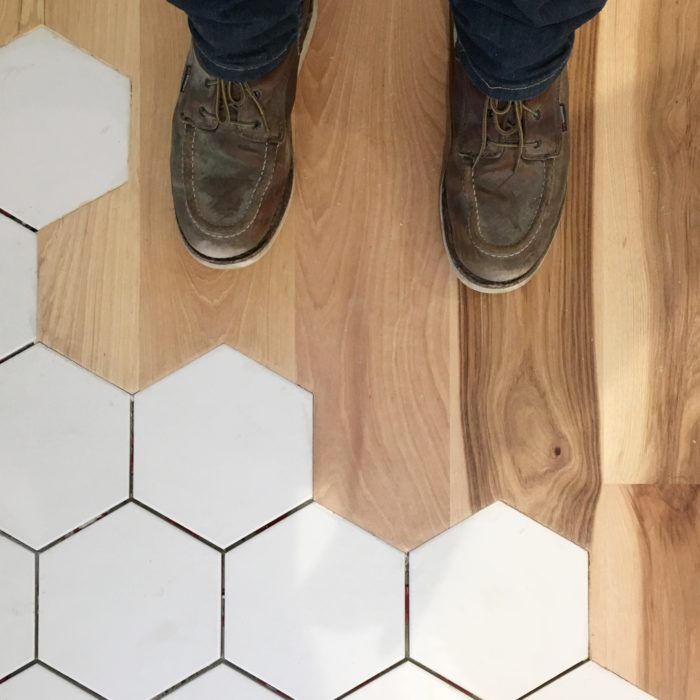
When I first came across an “organic” transition between tile and wood I knew immediately I needed to incorporate this design in my next build.
We installed 6″ Hickory floor throughout the first level with the exception of the mudroom and half of the kitchen, which featured a 7″x8″ blanco hexagon tile. My approach was to run the hexagon diagonally through the center of the kitchen island but to do it at random. Some stopping short of the “diagonal line” and some running long. I refer to this as an “organic” transitions because we’re not cutting the tile, nor are we fixed to a specific line, instead we are letting the tile flow into the wood at random.
This floor wasn’t even done before being contracted to include this design in another build. This job included narrow white oak and 14″x16″ hexagon tile, but again an “organic transition” between the two.
Tile Installation
Tile is installed just like any other tile floor, it starts with the layout. We laid the tile out on the floor in their approximate locations. Marking on the subfloor where the transition will roughly occur, so when we installed the underlayment we don’t spread the thin set too far.
We need to make sure the elevation is correct at 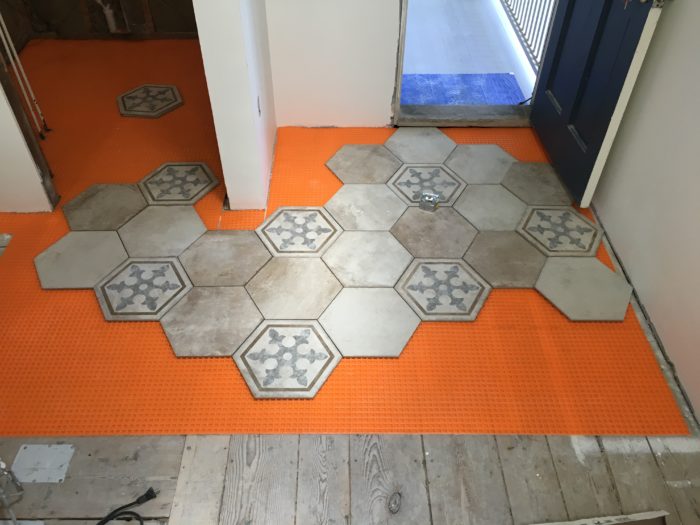 the transition. In our case, the wood flooring is 3/4″ thick so we need the tile to be installed at the same height. We opted for Schluter Ditra-XL which sat the tile at the same height as the wood flooring. Few reasons why we opted for this, over say a backer board: Existing subfloor wasn’t going to be replace, nor could we build it up (the new wood flooring was also tying into existing flooring in the adjacent rooms), we wanted an uncoupling membrane to allow the tile to be separated from the same subfloor the wood flooring would be nailed to, and finally it’s super easy to cut the “organic” edge.
the transition. In our case, the wood flooring is 3/4″ thick so we need the tile to be installed at the same height. We opted for Schluter Ditra-XL which sat the tile at the same height as the wood flooring. Few reasons why we opted for this, over say a backer board: Existing subfloor wasn’t going to be replace, nor could we build it up (the new wood flooring was also tying into existing flooring in the adjacent rooms), we wanted an uncoupling membrane to allow the tile to be separated from the same subfloor the wood flooring would be nailed to, and finally it’s super easy to cut the “organic” edge.
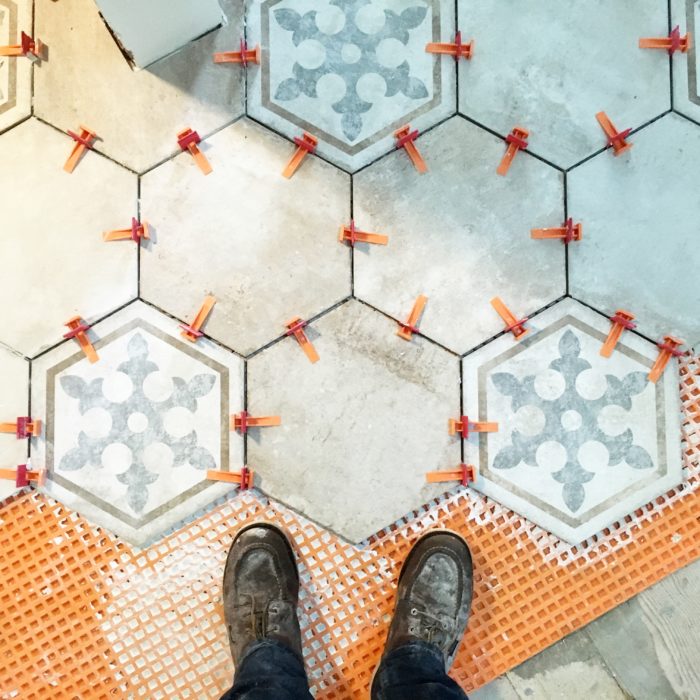 Ditra-XL was installed with TEC Super Flex modified thin set, and the tile with Laticretes 317 unmodified thin set. We installed the Ditra-XL over the entire area plus some, incase our approximate locations weren’t exact (they weren’t). Tile was installed with AcuFloor Leveling Spacers to keep the tile super flat in preparation for the wood transition.
Ditra-XL was installed with TEC Super Flex modified thin set, and the tile with Laticretes 317 unmodified thin set. We installed the Ditra-XL over the entire area plus some, incase our approximate locations weren’t exact (they weren’t). Tile was installed with AcuFloor Leveling Spacers to keep the tile super flat in preparation for the wood transition.
After the tile was setup, we went back with a utility knife and cut the Ditra-XL flush with the edge of each tile, chipping and flattening out any excessive thin set. We grouted and prepped for the wood floor install.
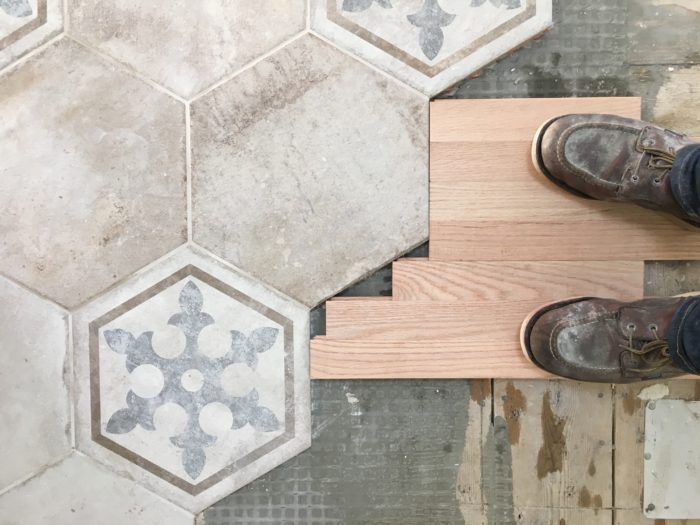
Wood Installation
The wood flooring was installed in a normal fashion and each board was scribed tight against the tile with a slight bevel. We were cautious to make sure the wood floor was always just slightly above the tile height so it could be sanded. The tiles were then taped with G-Tapes 1009GR to protect the edges and the wood floor was sanded and finished to match the existing home.
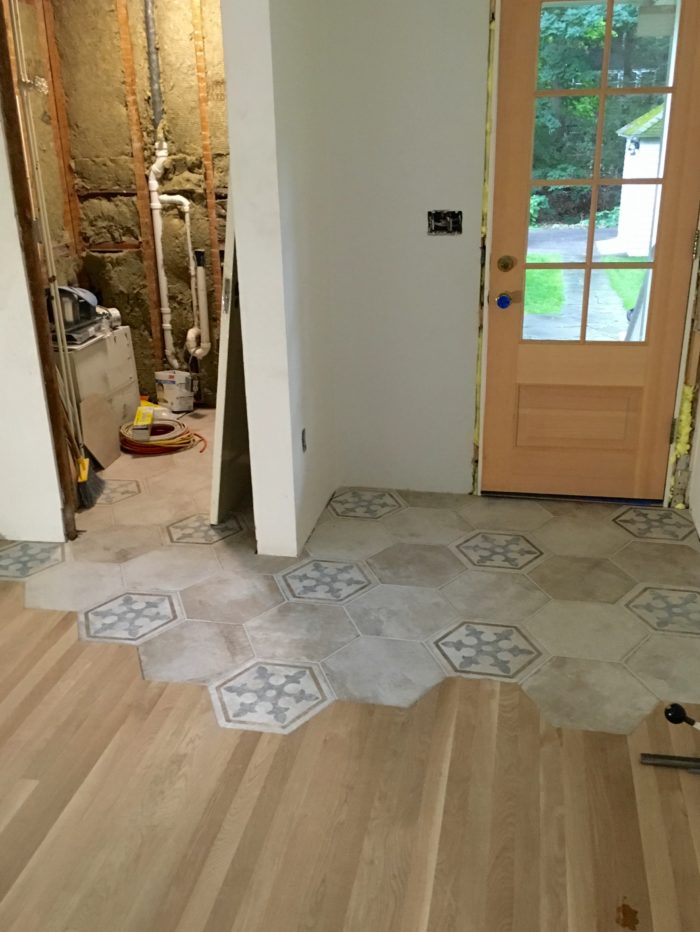
What about expansion?
The big question was always the concern with the wood flooring pushing on the tile. We discussed this with a number of wood flooring pros. Our use of the uncoupling membrane and the fact that the opposite end of each flooring run was left loose against the wall (baseboard will be installed on top of the floor) would allow for enough room to prevent any issues with expansion. If we had installed the wood floor tight on the opposite end, we would have left 1/8″ gap between the wood and tile, and used a grout colored caulking to span the gap.
Fine Homebuilding Recommended Products
Fine Homebuilding receives a commission for items purchased through links on this site, including Amazon Associates and other affiliate advertising programs.

Musings of an Energy Nerd: Toward an Energy-Efficient Home

Not So Big House

The New Carbon Architecture: Building to Cool the Climate






View Comments
It's a hassle leaving a comment on this website, so you know a guy really means it when he does--and this is, really, really cool. Thank you.
Looks cool! So, the membrane get fixed to the old 1bi subfloor with flexible thin set and the tile gets fixed to the membrane with non-modified thin set? How long does the flexible stay flexible? Not to put down this method since I have never used it, but with seasonal wood movement of the subfloor I would think in a few years the grout would start to pop?
I'm going to attempt this organic transition in my 1977 dodge vanguard with the vinyl allure locking smoked oak from home Depot. Is it still possible to do this properly if your not using real wood?